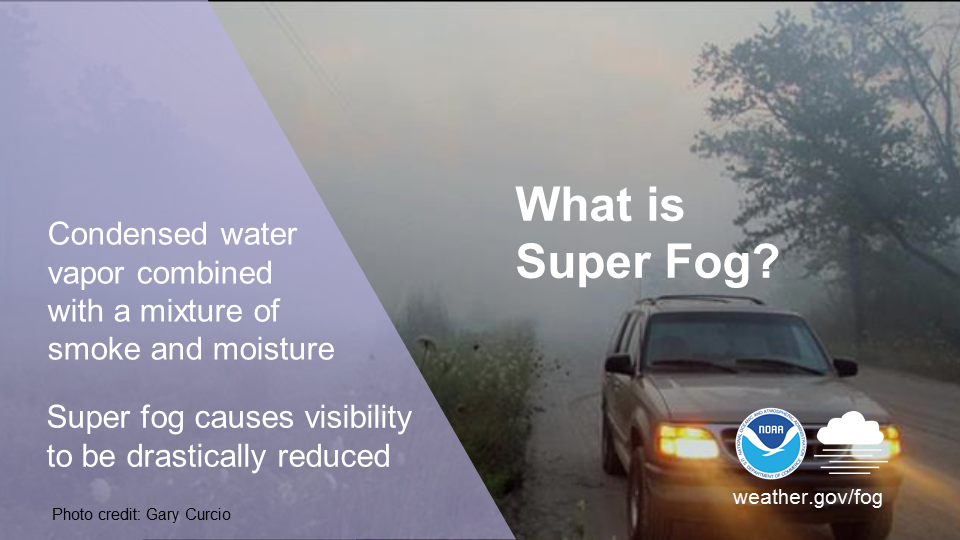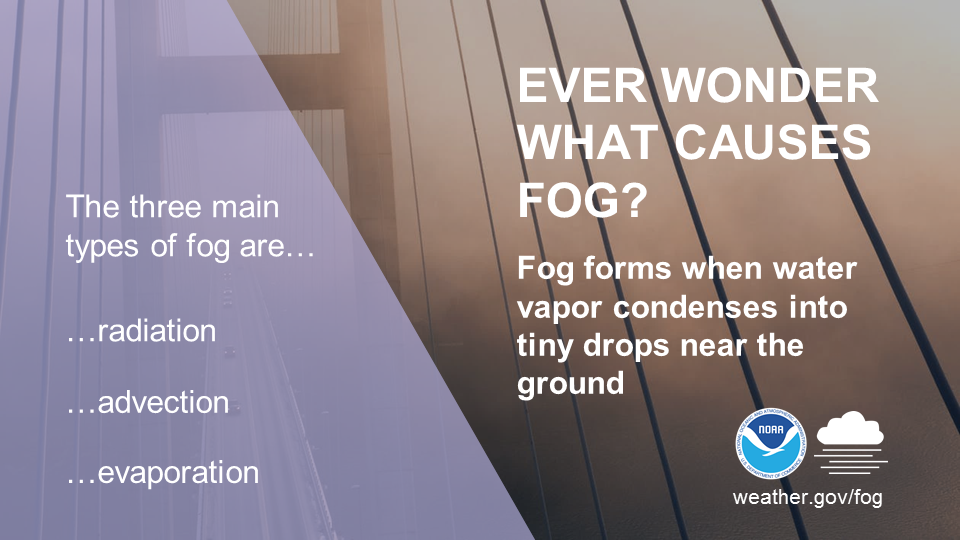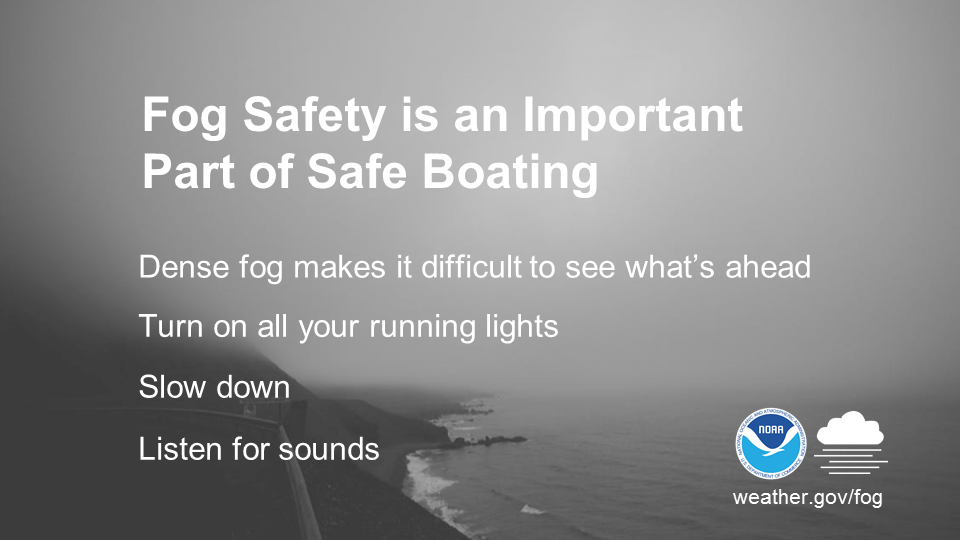Please help the National Weather Service spread these important safety messages on social media! Everyone is welcome to use the text and images provided below to help the NWS build a Weather-Ready Nation.
Facebook
Fog limits visibility, delays air travel, brings danger to the roads, and makes things generally spooky. But, how does it form? Watch this short video: youtu.be/QkRqjcO1ROk #FogScience
Twitter
Fog limits visibility, delays air travel, brings danger to the roads, and makes things generally spooky. But, how does it form? Watch this short video: youtu.be/QkRqjcO1ROk #FogScience
Facebook
If fog reduces your visibility while driving, do not change lanes or pass other vehicles unless absolutely necessary. Be sure that you can stop within the distance that you can see. weather.gov/safety/fog #FogSafety #FallSafety
Twitter
Do not change lanes or pass other vehicles unless absolutely necessary when driving in #fog. weather.gov/safety/fog #FogSafety

Facebook
Do you know how valley fog is created? First, air at higher elevations cools down, which then drains downslope into the valley. From there, a cool, stable layer forms near the ground, which limits turbulent mixing and traps the cool, moist air. Finally, the air near the ground continues to cool until water vapor molecules are changed into small droplets of liquid water. weather.gov/safety/fog-mountain-valley #FogScience
Twitter
Do you know how valley fog is created? weather.gov/safety/fog-mountain-valley #FogScience

Facebook
Dense fog reduces visibilities to a quarter mile or less, which could result in motor vehicle accidents. Here’s what you can do if your vehicle breaks down in dense fog. Move your disabled vehicle to the shoulder of the road, only keep the hazard lights on, and if possible, walk away from the road. Learn more about #FogSafety by visiting weather.gov/fog.
Twitter
Do you know what to do in dense fog if your car breaks down? Check out weather.gov/fog #FogSafety #FallSafety

Facebook
What is super fog? Generally, fog is formed by air moving over a ground of colder temperature, which causes water vapor in the air to condense into tiny liquid droplets. Super fog is caused by this condensed water vapor combining with a mixture of smoke and moisture released from damp smoldering organic material such as brush, leaves and trees. When super fog is formed, visibility is drastically reduced, often to no more than a few feet. weather.gov/safety/fog-super #FogScience
Twitter
What is super fog? Find out at weather.gov/safety/fog-super #FogScience

Facebook
Fog reduces visibilities and contributes to numerous motorist accidents every year. Dense Fog Advisories are issued when visibility drops to or is expected to drop to one quarter mile or less. Take caution and check to see if there are any Dense Fog Advisories issued for your commute before driving. Learn more about #FogSafety by visiting weather.gov/fog. #FallSafety
Twitter
Driving in fog can be hazardous. Take caution. Learn more about #FogSafety by visiting at weather.gov/fog #FallSafety

Facebook
Slowing down is the most important thing you can do to drive safely in dense fog. Reduced visibilities can lead to motor vehicle accidents. Visibility is usually the lowest on bridges and near bodies of water. Learn more about #FogSafety by visiting weather.gov/fog. #FogSafety #FallSafety
Twitter
Please slow down when driving in dense fog. weather.gov/fog #FogSafety #FallSafety

Facebook
If fog reduces your visibility while driving, do not change lanes or pass other vehicles unless absolutely necessary. Be sure that you can stop within the distance that you can see. weather.gov/safety/fog #FogSafety #FallSafety
Twitter
Do not change lanes or pass other vehicles unless absolutely necessary when driving in #fog. weather.gov/safety/fog #FogSafety

Facebook
Driving in fog can be dangerous. Be on the lookout for sudden changes in visibility. The patchy nature of fog can lower visibility quickly especially if you are driving fast, so be sure to slow down. Visibility may also be lower near rivers. weather.gov/safety/fog #FogSafety #FallSafety
Twitter
The patchy nature of #fog can lower visibility quickly—slow down and stay alert! weather.gov/safety/fog #FogSafety #FallSafety

Facebook
Fog forms when water droplets are present in the air near the earth's surface. There are several different types of fog—radiation fog, advection fog, freezing fog and others—but all can be hazardous to drivers, boaters or aviators. Learn more about fog and how to stay safe from it when on the road, on the water or in the air. weather.gov/safety/fog #FogSafety #FallSafety
Twitter
Learn about different types of fog and the threat they can pose if you’re driving, boating or flying: weather.gov/safety/fog

Facebook
If you're a boater, chances are you’ve at least occasionally encountered reduced visibility in fog, and you will need to know how to navigate through it safely. Visibility can be reduced to a just few feet, disorienting boaters. weather.gov/safety/fog #FogSafety #FallSafety
Twitter
Knowing how to navigate through fog safely is an important part of safe boating. weather.gov/safety/fog #FogSafety #FallSafety

Facebook
Your local NWS forecast office will issue a Dense Fog Advisory when widespread or localized fog is expected to reduce visibility to a quarter mile or less over a large area for an extended period of time, usually two hours or more. Learn more about fog safety: weather.gov/safety/fog-ww #FogSafety
Twitter
Learn about Dense Fog Advisories and what you need to know if one is issued for your area weather.gov/safety/fog-ww #FogSafety
